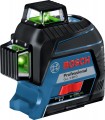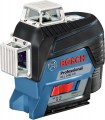Accuracy
Accuracy is described as the maximum deviation from the true value of the measured parameter, which the device can give if all the rules for its operation and the corresponding measurements are observed. In both rangefinders and levels, this parameter is usually designated for a certain distance — for example, 3 mm at 30 m; but even for one manufacturer, these "control" distances may be different. Therefore, in our catalog, the accuracy of all devices is recalculated for 1 m distance; with such a record, for the example above, it will be 3/30 \u003d 0.1 mm / m. This makes it easier to compare different models with each other.
It is also worth mentioning that the meaning of the "accuracy" parameter for different types of measuring instruments (see "Type") will be different. For optical levels, it is described in the "SKP" paragraph above. For laser levels of all types, accuracy is the maximum deviation of the mark from the true horizontal (or vertical, if such a function is provided), and for the horizontal, we can talk about both moving the mark up / down and turning it. In rangefinders, this characteristic describes the maximum difference (both in "plus" and "minus") between the readings of the device and the actual distance to the object.
Anyway, the smaller the error, the better; on the other hand, accuracy significantly affects the price of the device. Therefore, it is necessary to choose a specific model for this parameter, taking into account the...specifics of the planned work. For example, for a relatively simple repair in a residential apartment, a high-precision tool is unlikely to be required; and recommendations for more complex tasks can be found in specialized sources, ranging from expert advice to official instructions.
Bluetooth
The presence
of a Bluetooth module allows you to broadcast the measurements to the connected device. Thus, you can make the device as compact as possible, and read the received data directly from the phone. And in the era of high technology and the ability to control the phone with any device, such a decision looks quite reasonable.
Power source
The type and number of batteries used in the level/distance meter. All elements of standard sizes (
AA,
AAA,
C,
D,
PP3) are available in two formats — disposable batteries and rechargeable batteries. This gives the user a choice: either buy relatively inexpensive batteries every time, or invest once in a rechargeable battery with a charger, and then simply charge the battery as needed.
Branded batteries are, by definition, made only rechargeable, as are
18650 batteries.
Specific types of power today can be as follows:
— AA. A standard battery, known as a "finger battery". The power of these batteries is average, they can be used both in simple and quite advanced devices. This power supply is convenient due to the fact that AA batteries are very widespread and sold almost everywhere — due to this, finding and replacing them is usually not a problem.
— AAA. A smaller version of the AA element described above — almost identical in shape, but thinner and shorter. Such elements, known as "mini-finger" or "little fingers", have a rather low capacity and power, but are useful for portable devices, where compactness is crucial. They are also quite widespread.
— C. A cylindrical element, in the form of a rather thick "bar
...rel" — with a length of 50 mm, the diameter is 26 mm. Due to its higher capacity and power than AA, it is better suited for advanced models with "long-range" lasers, but is less commonly used and generally less common.
— D. The largest and most capacious type of standard batteries found in modern levels and distance meter: thickness and diameter are 62 and 34 mm, respectively. The main area of application for D batteries is powerful professional devices.
— Rechargeable battery. In this case, the tool is powered by an branded battery that does not belong to any standard size. This option is good because such batteries are initially created for a specific model of the level/distance meter and are supplied in the set (and in some models they are made non-removable); in addition, their specifications can significantly exceed those of standard elements of a similar size and weight. On the other hand, such power source is less convenient when the charge runs out at the wrong moment: the only way to remedy the situation is usually to recharge, and it takes quite a long time (whereas standard batteries can be replaced in just a minute).
– 18650. The name of these batteries comes from their dimensions: 18.6x65.2 mm, cylindrical, outwardly they resemble somewhat enlarged AA batteries, but they have an operating voltage of about 3.7 V and a higher capacity. In addition, all 18650 type batteries are by definition not disposable, but rechargeable batteries (lithium-ion type).
— PP3. 9-volt batteries of a spesific rectangular shape, with a pair of contacts on one of the ends. Due to the high operating voltage, they provide high power and actual capacity, so one such battery is usually enough for operation.
— LR44. Miniature batteries of "coin" type, 11.6 mm in diameter and 5.4 mm thick. Usually installed in sets of 3 and are used in compact low-power laser levels, for which small size is more important than power and capacity. Note that specifically the LR44 marking refers to relatively inexpensive alkaline batteries; more expensive and advanced silver-zinc power supplies are referred to as SR44, or 357.
— 23A12V. A rather rare option: cylindrical batteries (length 29 mm, diameter 10 mm) with a nominal voltage of 12 V.Operating time
Operating time of the device on one battery charge.
It is worth considering that these figures are quite approximate, since the operating time is measured under certain standard conditions (usually continuous operation at nominal power). And since in practice conditions may differ markedly, the operating time may turn out to be noticeably shorter or longer than stated. In addition, if the device uses replaceable batteries (AAA, AA and the like), then autonomy will also depend on the quality of the specific batteries/accumulators. Nevertheless, based on the data specified in the characteristics, it is quite possible to evaluate the capabilities of specific models and compare them with each other: the difference in the declared operating time, as a rule, proportionally corresponds to the difference in practical autonomy under the same conditions.
We also note that the operating time is specified mainly for levels; in rangefinders another parameter is more often used - the number of measurements (see below).
Battery platform
The name of the battery platform supported by the device. A single battery platform is used to combine various power tools of the same brand into one line (screwdriver, grinder, circular saw, etc.). Devices on the same platform use interchangeable batteries and chargers. Thanks to this, for example, there is no need to select a battery for each individual model of a power tool, because one purchased as a spare battery can be used in various power tools, depending on the situation or as needed. Batteries of the same platform basically differ from each other except perhaps in capacity.
Battery type
The model of a standard battery allows you to find out its characteristics in more detail, and also helps you understand what devices it is like and which one should be purchased in case of a replacement due to a malfunction or, if necessary, buy another similar one.
Compatible batteries
Battery models that the corresponding type of electric planer is compatible with (see "Power Source"). This information will be useful in cases where the battery(ies) must be purchased separately, for example, if the tool does not come with a battery at all, if you need to supplement the original package, or if the existing battery has failed.
In box
—
holder. Devices for fixing the level / range finder on various surfaces. Such a device differs from a tripod primarily in its small size — within a couple of tens of centimeters. On the other hand, most holders allow you to install the device not only on horizontal, but also on vertical surfaces — for example, walls (and some are exclusively wall-mounted). Anyway, this function greatly expands the installation possibilities.
—
Receiver. laser radiation supplied with the device. This device is usually equipped with laser levels, less often with rangefinders, and it is not required at all for optical instruments. The main purpose of the receiver is situations where the laser mark is not visible to the naked eye — for example, at a long distance or in bright light. More details on the features of its application are described above in the paragraph “Measurement range (with receiver)”.
—
Tripod. Most modern instruments have a standard size thread and can be used with any suitable tripod. On the other hand, a complete tripod is most often specially designed for a certain model and optimally matches it in terms of general characteristics. In addition, this configuration option relieves you of the need to look for and purchase a suitable tripod yourself.
—
Case / case. The main function of these devices is to protect
...the device from bumps, scratches, dirt, temperature changes and other adverse effects; for this, of course, improvised means can also be used, but specialized protection is usually both more convenient and more reliable. In addition, almost all cases and most covers greatly simplify the transportation of the tool — in particular, due to the fact that they can also be used for complete accessories.
— Remote control. Among rangefinders and optical levels, this function is practically not found, because. working with them involves the constant stay of the device in the hands of the operator. But for laser levels that require you to regularly move from the device to the surface to be marked and back, the remote control can be a very useful addition — due to the fact that it minimizes such movements. For example, after marking the "front of work" on the wall according to the projection from the level, you do not have to approach the device to turn it off — just give a command from the remote control. At short distances, the savings in time and effort may not be so obvious, but over large areas, they can become quite noticeable.
